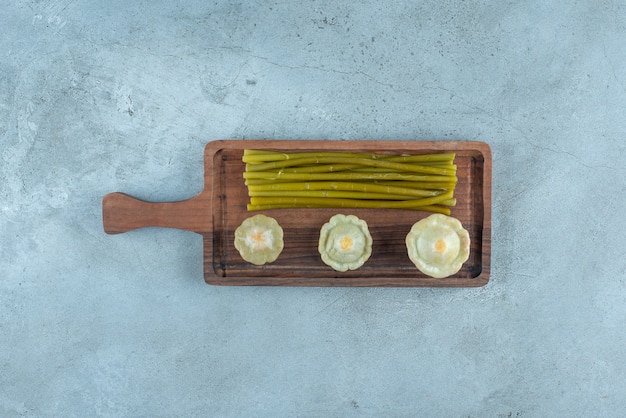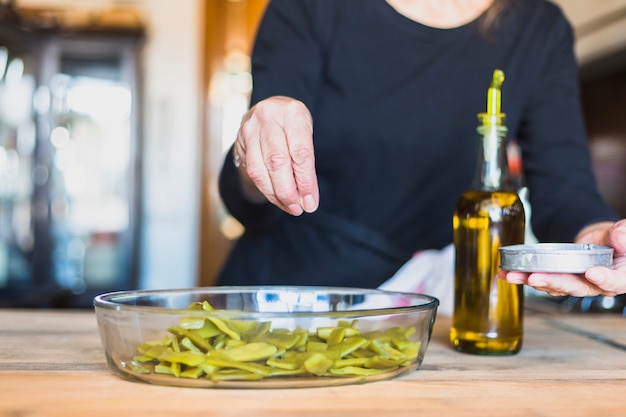Ah, asparagus. The harbinger of spring, a symbol of fresh beginnings and sunshine after a long, cold winter. There's just something about that vibrant green spear that makes my mouth water. I can practically taste the delicate crunch, the earthy sweetness, the hint of bitterness that just elevates the flavour to another level. But let's be honest, there's a fine line between perfectly roasted asparagus and a limp, sad, overcooked mess. And that's where the timing comes in.
Part 1: The Oven is Your Canvas

The first thing you need to understand is that roasting asparagus isn't just about chucking it in the oven and hoping for the best. It's an art form, my friend. It's about creating the perfect environment for those spears to develop their full flavour and texture. That means understanding your oven, its quirks, its heat distribution, and how it interacts with those precious green bundles.
1.1: Knowing Your Oven's Personality
I've been there, staring at a brand new recipe, thinking, "this is going to be amazing!" Only to end up with asparagus that's either burnt to a crisp or still crunchy raw. The culprit? My oven. It's a bit of a diva, sometimes hotter in one corner than the other. So, I've learned to know its moods, its quirks. And you should too.
Every oven is unique. Some are hotter than others, some have uneven heat distribution, and some just seem to have a mind of their own. Before you start roasting, take a moment to get to know your oven's personality. This is crucial to mastering the art of roasting asparagus and ensuring you get that perfect, tender-crisp texture every time.
1.2: Oven Temperatures: The Goldilocks Zone
Don't just blindly follow a recipe that tells you to cook asparagus at 400°F (200°C). That's a good starting point, but every oven is different. Test it out. Stick a thermometer inside and see how it actually heats up. You might find it's a bit hotter or cooler than expected. This little experiment will save you a lot of heartache later on.
Remember, we're aiming for a steady, consistent heat. Too hot and you'll risk burning the asparagus before it has a chance to cook through. Too cool, and you'll end up with limp and undercooked spears. Find that sweet spot, that Goldilocks zone where the oven is just right.
Part 2: Prepping for Perfection

It's not just about the oven; it's also about setting up your asparagus for success. Think of it like a runway model, getting prepped for a big show. Every little detail matters.
2.1: Trimming for Texture
Let's talk about those tough ends. You've got to give them the chop, my friend. No one wants to chew on wood. I usually snap them off with my fingers – you can hear a distinct "snap" when you get to the tender part.
This simple step makes a huge difference in the overall texture of your roasted asparagus. The tough ends won't soften even with prolonged cooking, and they can make the whole dish unpleasant to eat. So, take the time to trim them off.
2.2: The Wash and Rinse
A quick rinse under cold water is all you need. No need to soak them for hours. I find that a gentle pat dry with a clean tea towel helps to prevent them from steaming too much in the oven.
Washing the asparagus removes any dirt or debris and helps to refresh the spears. But be careful not to over-wash them, as this can lead to soggy asparagus. A quick rinse and a gentle pat dry is all you need to get them ready for the oven.
2.3: The Oil Bath
Think of it as a mini spa treatment for your asparagus. A light drizzle of olive oil is all you need to help the spears cook evenly and develop a nice golden-brown colour. Don't be shy with the seasoning – a sprinkle of salt and pepper does wonders.
The oil coats the asparagus, preventing it from sticking to the baking sheet and ensuring even browning. It also helps to lock in moisture and enhance the flavour of the asparagus. Seasoning adds depth and complexity, and a little goes a long way.
Part 3: Time for the Roast

Okay, now we're getting into the heart of the matter – the roasting time. It's not an exact science, but here's a general guideline that's worked wonders for me.
3.1: The Thickness Factor
Asparagus isn't a one-size-fits-all deal. Those thick spears need a bit more time than their thinner counterparts. So, size matters.
Thicker asparagus spears have a larger volume, meaning they take longer to cook through. Thin spears cook quickly, so they require a shorter roasting time. Consider the thickness of your asparagus when determining the roasting time.
3.2: The Roasting Rhythm
For thinner asparagus, 10-15 minutes at 400°F (200°C) is usually enough to get them tender-crisp. For thicker spears, bump up the time to 15-20 minutes. But remember, every oven is different, so keep an eye on those spears!
This is just a starting point. You'll need to adjust the roasting time based on your oven and the thickness of your asparagus. It's always better to err on the side of undercooked, as you can always roast them a bit longer if needed. But once you've overcooked asparagus, there's no going back.
3.3: The Visual Cue
Don't just rely on the timer. Use your eyes! Look for a slightly golden-brown colour and a gentle bend. If it snaps easily, it's probably ready.
Your eyes are your best guide. The asparagus should have a slightly golden-brown hue, indicating that it's cooked through. It should also be tender but still have a slight bite to it. If it bends easily without snapping, it's ready to go.
Part 4: The Finishing Touches
Your asparagus is almost ready to shine! But there are a few tricks up my sleeve to take it from good to absolutely delicious.
4.1: The Squeeze of Lemon
A squeeze of lemon juice adds a touch of brightness and acidity that balances out the sweetness of the asparagus. It's a simple trick that makes a big difference.
The acidity of the lemon juice cuts through the sweetness of the asparagus, adding a refreshing touch and enhancing the overall flavour profile. It's a classic pairing that elevates the asparagus to another level.
4.2: The Sprinkle of Herbs
Fresh herbs like parsley, dill, or chives add a burst of flavour and freshness. Just sprinkle them on top of your roasted asparagus for an extra punch.
Fresh herbs bring an aromatic dimension to the roasted asparagus. They add complexity and depth to the flavour and provide a visual contrast to the green spears. A sprinkle of herbs makes your dish more visually appealing and incredibly aromatic.
Part 5: The Delicious Variations
The beauty of roasted asparagus is its versatility. You can play around with different flavours and textures to create endless variations.
5.1: The Cheesy Delight
For a cheesy twist, sprinkle grated parmesan or cheddar cheese over your asparagus before roasting. The cheese melts and creates a delicious, gooey topping.
The cheese adds a creamy, salty flavour that complements the asparagus perfectly. The melting cheese creates a rich, gooey topping that makes the dish even more indulgent and satisfying.
5.2: The Spicy Kick
If you like a bit of heat, add a pinch of red pepper flakes or a drizzle of sriracha sauce to your asparagus before roasting. It's a quick and easy way to add some spice to your dish.
For those who enjoy a little heat, red pepper flakes or sriracha sauce add a spicy kick that brings a whole new dimension to the dish. These spices complement the asparagus by providing a contrast in flavour and texture, making the dish more exciting and dynamic.
5.3: The Sweet and Savoury Combination
For a unique twist, try roasting your asparagus with a drizzle of honey and a sprinkle of toasted sesame seeds. The sweetness of the honey complements the earthy flavour of the asparagus perfectly.
The honey and sesame seeds add a sweet and nutty flavour that balances the earthy notes of the asparagus. This unexpected pairing creates a delicious, surprising flavour combination that will surely impress your guests.
Part 6: Storing Your Roasted Asparagus
Let's be honest, sometimes you make more asparagus than you can eat in one sitting. Don't worry, you can store it!
6.1: The Fridge Friendly
Let the asparagus cool completely before storing it in an airtight container in the refrigerator. It'll stay fresh for up to 3 days.
Storing the asparagus properly is essential to ensure it stays fresh and flavorful. Allow it to cool completely to prevent condensation in the container, which can make the asparagus soggy. Store it in an airtight container to preserve its texture and flavour.
6.2: Reheating Tips
To reheat, simply pop it back in the oven at 350°F (175°C) for about 5-10 minutes. You can also reheat it in a microwave, but it might lose a bit of its crunch.
Reheating roasted asparagus is easy. The oven is the best method for preserving the texture and flavour. The microwave is a quick and convenient option, but it might make the asparagus a bit soft and limp.
Part 7: The Asparagus Adventure
Roasted asparagus isn't just a side dish; it's an adventure. It's about experimenting with different flavours and textures, about discovering what you like best. It's about embracing the unexpected and trying something new.
The beauty of roasted asparagus lies in its endless possibilities. Don't be afraid to experiment with different flavour combinations, herbs, spices, and toppings. The more you experiment, the more you'll discover your favourite ways to enjoy this delicious spring vegetable.
Part 8: FAQs
Here are a few frequently asked questions about roasted asparagus:
| Question | Answer |
|---|---|
| What happens if I overcook asparagus? | Overcooked asparagus will be limp and mushy. It will lose its vibrant green colour and become dull. The flavour will also be less intense and less pleasant. It's best to err on the side of undercooked, as you can always roast it a bit longer if needed. |
| Can I roast asparagus with other vegetables? | Absolutely! Asparagus pairs well with many other vegetables, such as cherry tomatoes, bell peppers, and onions. This creates a delicious and colourful medley that's perfect for a side dish or a light meal. |
| Can I roast asparagus in advance? | Yes, you can roast asparagus in advance and reheat it later. Just let it cool completely and store it in an airtight container in the refrigerator. This is a great time-saving tip for busy weeknights. |
| How can I tell if asparagus is fresh? | fresh asparagus will have firm spears with tightly closed tips. The spears should be vibrant green and free of blemishes. If the tips are open or the spears are limp, the asparagus is probably not as fresh. |
| What are some good pairings for roasted asparagus? | Roasted asparagus goes well with grilled fish, chicken, pork, and steak. It's also delicious with a creamy sauce, like a hollandaise or béarnaise. The flavour combinations are endless, so feel free to experiment and find your favourites. |
So, there you have it, my friends. A guide to roasting asparagus that will make your taste buds sing and your kitchen smell divine. Go forth and experiment, and remember, there's no right or wrong way to do it. It's your culinary journey, and every bite is an adventure. Happy roasting!
Everyone is watching

How to Cook Frozen Lobster Tails Perfectly: A Step-by-Step Guide
RecipesLobster. Just the word conjures up images of lavish meals, special occasions, and a taste of luxury. But let's...

Pigs in a Blanket Cooking Time: How Long to Bake for Perfect Results
RecipesAh, pigs in a blanket. Just the name conjures up images of those delightful little parcels of crispy pastry en...

Pork Fillet Cooking Time: How Long to Cook It Perfectly
RecipesPork fillet, or tenderloin as it's sometimes called, is a real favourite in our house. It's so versatile, and...

The Ultimate Guide to Tender, Juicy Pulled Pork
RecipesRight, let's talk pulled pork. It's one of those dishes that just screams "comfort food," doesn't it? I mean...

The Ultimate Guide to Cooking Delicious Frankfurters
RecipesLet's face it, we all love a good frankfurter. It's a classic, simple, and always satisfying. But let's be rea...
